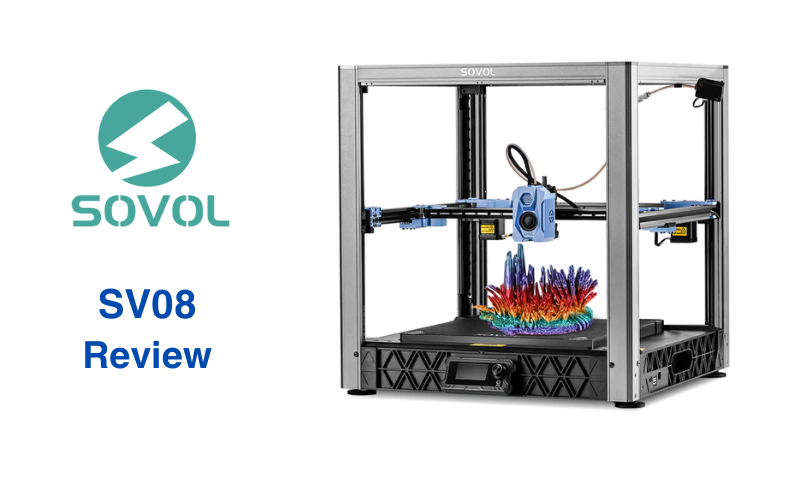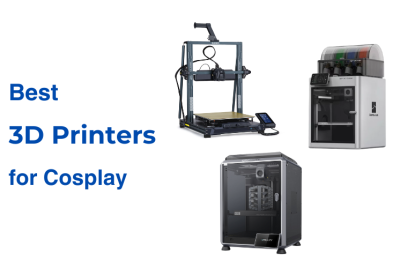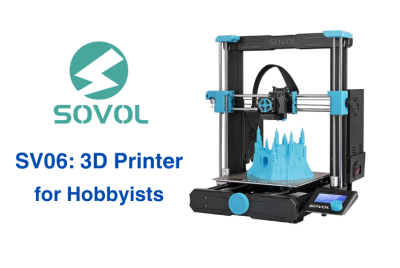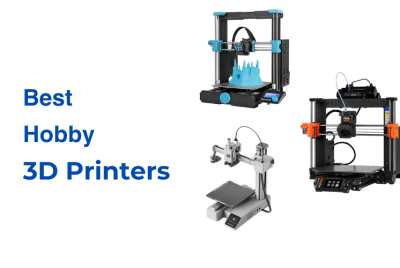Sovol SV08 Review
Sovol entered the 3D printing market in 2018, quickly gaining attention for its affordable machines that featured upgrades typically found in higher-priced models. Their early releases, like the SV01, included direct drive extruders. This was an uncommon feature for budget printers at the time. It gave users more control when printing flexible materials such as TPU, addressing a common challenge for those using Bowden-style setups.
Since then, Sovol has steadily expanded its lineup to include both FDM and resin printers. They centered on practical upgrades and customization options. The SV06, released in 2022, became popular for its automatic bed leveling and open-source firmware, which allowed users to fine-tune their printers. Sovol has also introduced accessories, such as resin stations, to make post-processing more convenient for resin printing users.
In this Sovol SV08 review, we’ll take a closer look at their latest CoreXY 3D printer. We’ll cover its design, key features like fast printing, quad-gantry leveling and Klipper firmware, and how it performs for large-scale projects.
Design and Build Quality
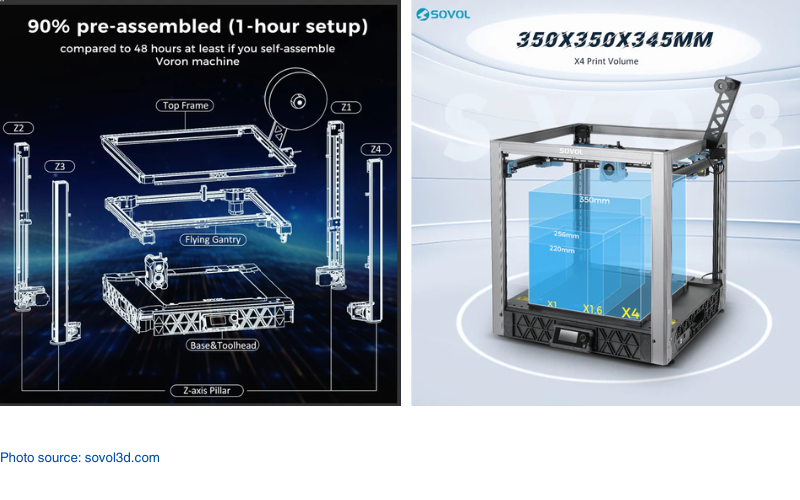
The Sovol SV08 has a sturdy CoreXY frame built for large prints and high-speed movement without shaking things up. The aluminum frame keeps everything solid but doesn’t add unnecessary weight. The use of linear rails on all axes—four for the Z-axis, two for the Y-axis, and one for the X-axis help guide the print head and platform smoothly. This keeps movement steady and accurate, even at faster speeds.
When it arrives, the SV08 is 90% pre-assembled, so setting it up doesn’t feel like a project on its own. Sovol estimates it takes about an hour to get everything ready, even if you’re adding the optional enclosure. The open-frame design supports a big build volume of 350 x 350 x 345 mm, giving you plenty of space for large prints. If you decide to add the top enclosure for better temperature control, the Z-axis height adjusts to 330 mm. However, Sovol gives an extension kit if you want to keep the full 345 mm height while using the enclosure.
One feature that helps keep prints consistent is the quad-gantry leveling system with four independent Z motors. This system levels the gantry and compensates for any uneven areas in the Z-axis. It’s a helpful addition when working with larger prints, where small inconsistencies can cause major problems.
Key Features and Specifications
The CoreXY system keeps the print head moving efficiently by reducing the weight of the moving parts. It lets the printer hit speeds of up to 700 mm/s with 40,000 mm/s² acceleration. To keep everything level, it uses four independent Z motors for quad-gantry leveling, which helps prevent sagging and keeps the prints consistent, even after long hours of use. Running on Klipper firmware, the SV08 uses features like Input Shaping to reduce vibrations and Pressure Advance to keep filament flow steady.
Linear rails on every axis help keep movements smooth and avoid slipping, even at higher speeds. The ceramic heating block and AC-heated bed heat up quickly, handling materials like PLA, PETG, and TPU with ease. On top of that, the built-in camera and remote control features let you monitor prints and make adjustments from your computer or phone. The SV08 also comes with a 5-inch touchscreen that you can reposition to fit your setup. It runs on the Mainsail interface, which gives you easy access to print controls, live monitoring, and settings. Altogether, the SV08 packs in what you need to handle large, detailed prints without a lot of hassle.
| Key Features | Specifications |
|---|---|
| Quad-Gantry Leveling with Independent Z Motors | Build Volume: 350 x 350 x 345 mm³ (open frame) / 350 x 350 x 330 mm³ (with enclosure) |
| CoreXY Motion System for Speed and Stability | Extruder Type: Direct Drive |
| Klipper Firmware Integration | Nozzle: 0.4mm hardened steel |
| All-Axes Linear Rails | Build Platform: PEI spring steel sheet, heated |
| OrcaSlicer Compatibility | Bed Leveling: Automatic (Quad-Gantry-Leveling) |
| Ceramic Heating Block and AC Heated Bed | Materials: PLA, PETG, TPU (up to 300°C) |
| Built-in Camera and Remote Monitoring | Connectivity: USB, Ethernet, Wi-Fi |
| 5″ touchscreen with Mainsail UI | File Formats: STL, OBJ |
Comparisons
Sovol SV08 vs Bambu Lab X1 Carbon
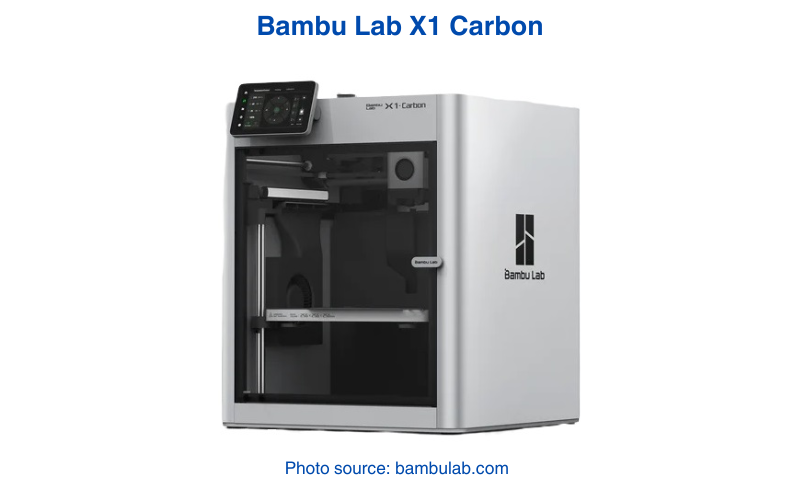
The Sovol SV08 and Bambu Lab X1 Carbon are both high-speed CoreXY printers, but they take different approaches to customization and performance.
- Printing System: Both use CoreXY for efficient movement. The SV08 has linear rails on all axes for added stability, while the X1 Carbon relies on proprietary hardware to maintain speed and accuracy.
- Build Volume: The SV08 offers 350 x 350 x 345 mm, giving more space for larger prints. The X1 Carbon’s 256 x 256 x 256 mm volume works better for medium-sized projects.
- Firmware and Customization: The SV08 runs open-source Klipper firmware, giving users more control over settings. The X1 Carbon uses Bambu Lab’s firmware, which simplifies operation but limits customization.
Sovol SV08 vs Rat Rig V-Core 3
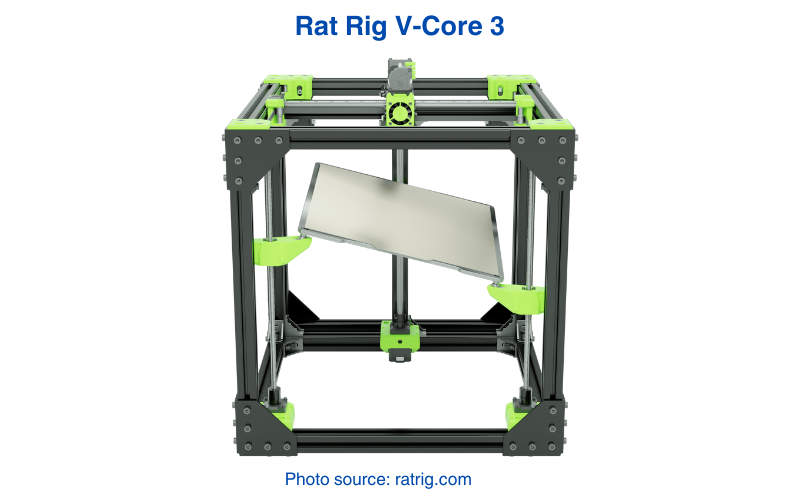
The Sovol SV08 and Rat Rig V-Core 3 share open-source roots and CoreXY designs, but their setups are very different.
- Printing System: Both use CoreXY for faster movement. The SV08 includes linear rails and quad-gantry leveling out of the box. The V-Core 3 supports similar features but requires more manual upgrades.
- Build Volume: The SV08’s build volume is 350 x 350 x 345 mm. The V-Core 3 can be configured for larger prints, but this adds time and cost.
- Firmware: Both run Klipper firmware for faster processing and improved print control. The SV08 comes pre-configured, while the V-Core 3 is a DIY kit that requires setup from scratch.
- Assembly: The SV08 is 90% pre-assembled and takes about an hour to set up. The V-Core 3 requires full assembly, which can take several hours or more, depending on experience.
Real World Applications
The Sovol SV08 can print everything, from creative home projects to small-scale production. It’s flexible for both beginners and veteran users.
- Prototyping and Design: The SV08’s large build space and CoreXY system make it great for printing prototypes and testing ideas. The Klipper firmware keeps movements smooth, even at high speeds, so you can print multiple versions quickly. The quad-gantry leveling prevents uneven layers, which is essential for big projects.
- Educational Use: With its open-source firmware, the SV08 works well for classrooms and makerspaces. Students can explore features like Input Shaping to see how different settings affect prints. The pre-assembled design makes it beginner-friendly but still advanced enough for more technical projects.
- Home Projects: For DIYers making cosplay props, home repairs, or decor, the SV08’s large print area and direct drive extruder handle detailed prints easily. The built-in camera and remote control let you monitor long prints without staying near the machine.
- Small Business and Production: The SV08’s fast speeds, large build size, and material support make it a good fit for small businesses making custom parts or prototypes. It handles batch printing well, and the quad-gantry leveling helps avoid failed prints, saving time and materials.
Final Notes
The Sovol SV08 brings a CoreXY system and quad-gantry leveling to help keep prints stable and accurate. With its spacious build volume and Klipper firmware, it’s well-suited for everything from prototypes to creative home builds.
The direct drive extruder and fast-heating bed handle a range of materials like PLA, PETG, and TPU easilyl. The pre-assembled design also cuts down setup time, so it’s a good choice even if you’re not used to putting together CoreXY printers.
Compared to similar models, the SV08 offers more freedom with its open-source firmware while still being easier to set up than DIY kits like the Rat Rig V-Core 3. It’s also a great alternative to pricier options like the Bambu Lab X1 Carbon, especially for users who want more control over their machine.
Overall, the SV08 is a capable 3D printer that works well for big projects, small production runs, and anyone who wants a machine they can customize without spending hours assembling or troubleshooting.

